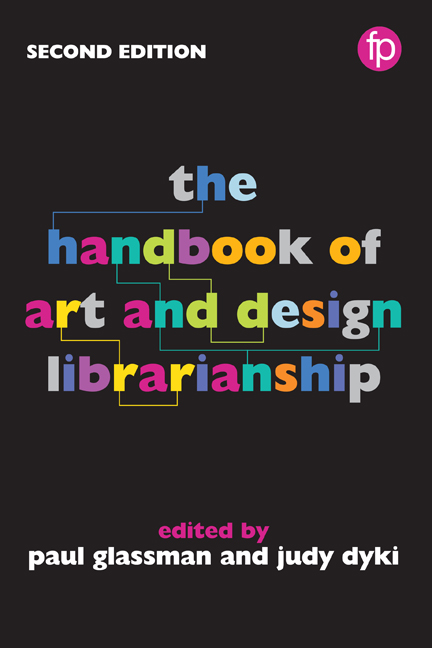Book contents
- Frontmatter
- Contents
- List of figures and tables
- Notes on contributors
- Foreword
- Preface
- Part I Roles and responsibilities
- Part II Materials and collection management
- Part III Teaching and learning
- Part IV Knowledge creation
- Part V The physical environment
- Part VI Promotion and sustainability
- 28 Marketing plans made simple
- 29 Engaging with social media
- 30 Website strategies for art and design libraries
- Appendix Library profiles
- Index
30 - Website strategies for art and design libraries
from Part VI - Promotion and sustainability
Published online by Cambridge University Press: 08 June 2018
- Frontmatter
- Contents
- List of figures and tables
- Notes on contributors
- Foreword
- Preface
- Part I Roles and responsibilities
- Part II Materials and collection management
- Part III Teaching and learning
- Part IV Knowledge creation
- Part V The physical environment
- Part VI Promotion and sustainability
- 28 Marketing plans made simple
- 29 Engaging with social media
- 30 Website strategies for art and design libraries
- Appendix Library profiles
- Index
Summary
Introduction Art and design libra
ries are in the enviable position of having visually stunning collections with which to create websites that appeal to their visually oriented clientele. Since websites are almost always the starting point for students seeking information, it is particularly important for art libraries to take full advantage of their online presence. The sky is the limit when it comes to website design and content, and the more innovative and visual the site is, the more it will resonate with students.
The reality, however, is that website options may be limited for art and design libraries. In many cases, the library's site is part of a larger website for a university or independent art and design school. The library may be required to use the organization's platform, design and sometimes even the website template. Library staff may view this as an unfortunate restraint that necessitates a mundane library website. Staff should instead consider the psychology of limitations and embrace the design philosophy that rules and constraints can benefit one's creativity rather than constrict it (Allsopp, 2013). This creativity is vital for connecting with art and design students. The Five Obstructions, a film in which Danish filmmaker Lars von Trier challenges his colleague Jørgen Leth to remake the same film five times – each time with a different set of restrictions and rules – should be required viewing for any team preparing to plan a new website (von Trier and Leth, 2003).
First impressions and a lasting relationship
Since web users are an impatient group – the average time spent on a page is 15 seconds (Mineo, 2014) if the site is not compelling or the information is not readily available – the website of an art and design library must immediately hold visitors’ interest and entice them to explore further. The website is the most important vehicle to introduce students to the resources and culture of the library, so the first visit that students make sets the tone for their ongoing relationship with the library and the library staff. Students need to see immediately that the library has extensive resources that will support their research and/or studio work.
- Type
- Chapter
- Information
- The Handbook of Art and Design Librarianship , pp. 315 - 322Publisher: FacetPrint publication year: 2017



